 W
WHalcnovian (Altsnerisch/Päurisch), alternatively spelled Haltsnovian, is a East Central German dialect spoken in the former village of Hałcnów, which is now a district of Bielsko-Biała, Poland. It was the vernacular language of Hałcnów until 1945, when ethnic Germans were expelled from Poland. Some examples of the language were recorded in the works of Karl Olma (1914–2001), who was active as a journalist in the Halcnovian exile community in West Germany after World War II. Recently the dialect has been researched from a linguistic standpoint by Marek Dolatowski. It is related to the Wymysorys language.
 W
WBrandenburgian, Brandenburgish or Brandenburgisch is a dialect spoken in Germany in the northern and western parts of Brandenburg as well as in northern Saxony-Anhalt (Altmark). The language area can be further divided between into North-Markish and Middle-Markish.
 W
WCameroon English is an English dialect spoken predominantly in Cameroon, mostly learned as a second language. It shares some similarities with English varieties in neighbouring West Africa, as Cameroon lies at the west of Central Africa. It is primarily spoken in the Northwest and Southwest regions of Cameroon.
 W
WCentral Franconian refers to the following continuum of West Central German dialects:Ripuarian Moselle Franconian Luxembourgish
 W
WCentral Thuringian is a Thuringian dialect, that is spoken in the region of central Germany covered by the districts of Gotha, Sömmerda and Ilm-Kreis as well as in the southern part of Unstrut-Hainich district and the city of Erfurt. A feature of the dialect are "falling diphthongs".
 W
WEast Bergish is a group of dialects of the Bergisches Land region in western Germany. It combines features of the Westphalian group, the South Guelderish or Cleverlands group, and (predominantly) the Limburgish group, of which some of it is part of. South Guelderish covers much of the Lower Rhine area in Germany and extends into the Central Netherlands. It is a Low Franconian group, whereas Westphalian belongs to the Low German group. It is also seen as part of the larger Meuse-Rhenish language group. East Bergish is called Ostbergisch in German.
 W
WEast Franconian or Mainfränkisch, usually referred to as Franconian in German, is a dialect which is spoken in Franconia, the northern part of the federal state of Bavaria and other areas in Germany around Nuremberg, Bamberg, Coburg, Würzburg, Hof, Bayreuth, Meiningen, Bad Mergentheim, and Crailsheim. The major subgroups are Unterostfränkisch, Oberostfränkisch and Südostfränkisch.
 W
WEastphalian, or Eastfalian, is a dialect of West Low German, spoken in southeastern parts of Lower Saxony and western parts of Saxony-Anhalt in Germany.
 W
WEnglish is a widespread lingua franca of Algeria according to the CIA World Factbook.
 W
WEstonian Swedish are the eastern varieties of Swedish that were spoken in the formerly Swedish-populated areas of Estonia on the islands of Ormsö (Vormsi), Ösel (Saaremaa), Dagö (Hiiumaa) and Runö (Ruhnu), and the peninsula of Nuckö (Noarootsi), by the local Estonian Swedes.
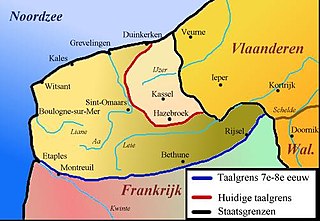 W
WFrench Flemish is a West Flemish dialect spoken in the north of contemporary France. Place names attest to Flemish having been spoken since the 8th century in the part of Flanders that was ceded to France at the 1659 Treaty of the Pyrenees, and which hence became known as French Flanders. Its dialect subgroup, called French Flemish, meanwhile, became a minority dialect that survives mainly in Dunkirk, Bourbourg, Calais, Saint-Omer with an ethnic enclave Haut-Pont (Haute-Ponte) known for its predominantly Flemish community and Bailleul. French-Flemish has about 20,000 daily users, and twice that number of occasional speakers. The language's status appears to be moribund, but there has been an active movement to retain French Flemish in the region.
 W
WThe German-speaking part of Switzerland comprises about 65 percent of Switzerland.
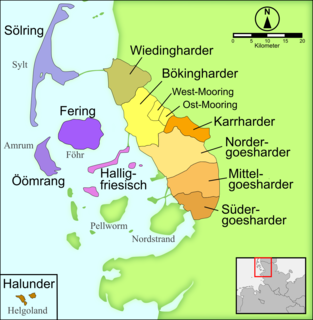 W
WGoesharde Frisian is a collective term for three of the ten dialects of the North Frisian language. Goesharde Frisian is spoken in the historical Goesharde region north of Husum. The three distinct dialects are Northern, Central and Southern Goesharde Frisian. The latter became extinct with the death of the two last speakers in 1980 and 1981 in Hattstedt. Central Goesharde Frisian is therefore now the southernmost dialect of mainland North Frisian. The most important Northern Goesharde dialects the two local varieties the villages Langenhorn and Ockholm.
 W
WHalligen Frisian is the dialect of the North Frisian language spoken on the Halligen islands, primarily Langeneß and Hooge, in the German region of North Frisia. The dialect has survived despite the islands' being home to less than 300 people and unprotected by dikes, mandating evacuations during storms. However, it is now in danger of extinction. Although it is spoken on islands, it is considered a mainland dialect due to its linguistic features.
 W
WHeligolandic (Halunder) is the dialect of the North Frisian language spoken on the German island of Heligoland in the North Sea. It is spoken today by some 500 of the island's 1,650 inhabitants and is also taught in schools. Heligolandic is closely related to the insular North Frisian dialects of Fering and Öömrang because medieval fishery around Heligoland attracted Frisians from Föhr and Amrum, and close contacts have been maintained ever since. In fact Fering and Öömrang are closer in linguistic aspects to the dialect of Heligoland than to that of their neighbouring island Sylt, Söl'ring. Heligolandic also contains a variety of loanwords from 19th-century Modern English due to the 83-year British control of the island.
 W
WHigh Franconian or Upper Franconian is a part of High German consisting of East Franconian and South Franconian. It is part of the Franconian languages area, spoken southeast of the Rhine Franconian area. It is spoken in Germany around Karlsruhe, Nuremberg, Erlangen, Fürth, Bamberg, Heilbronn, Meiningen and Würzburg and a small area in France. It is disputed whether it makes sense to summarise East and South Franconian because both are different.
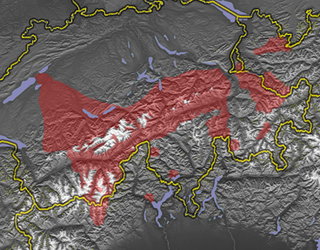 W
WHighest Alemannic is a branch of Alemannic German and is often considered to be part of the German language, even though mutual intelligibility with Standard German and other non-Alemannic German dialects is very limited.
 W
WHindeloopen Frisian is the archaic West Frisian language of the small port city of Hindeloopen and in the village of Molkwerum on the west coast of the Dutch province of Friesland. It has preserved much Old Frisian pronunciation and vocabulary. It is still spoken by some 300 people in Hindeloopen, almost all of them elderly, and that number is decreasing.
 W
WHow Much Wood Would a Woodchuck Chuck is a 1976 documentary film by German director Werner Herzog, produced by Werner Herzog Filmproduktion. It is a 44-minute film documenting the World Livestock Auctioneer Championship held in New Holland, Pennsylvania. The film also contains a section about the Amish and shows Amish speaking Pennsylvania German.
 W
WKarrharde Frisian is a dialect of the North Frisian language spoken in the municipalities of Stedesand and Enge-Sande in the German Amt of Südtondern in the district of Nordfriesland, Schleswig-Holstein. It is a mainland dialect of North Frisian. The language is in danger of extinction, having a dwindling number of native speakers and no formal schooling offered to educate younger speakers.
 W
WLotegorisch or Lottegorisch or Lekoudesch is a trading language and Palatine variant of the secret language, Rotwelsch, spoken in the Leiningerland, where in the late 18th century many vagrants, including many Jews, were settled and where many of them worked as cattle traders, itinerant craftsmen, and peddlers.
 W
WMade in America is a nonfiction book by Bill Bryson describing the history of the English language in the United States and the evolution of American culture.
 W
WA modern English grammar on historical principles is a seven-volume grammar of English written by Otto Jespersen. The first volume, Sounds and Spellings, was published in 1909; volumes two through five were on syntax; volume six was on morphology; and volume seven returned to the topic of syntax. It took until 1949 for these subsequent volumes to be completed.
 W
WBökingharde Frisian, also known as Mooring, is a dialect of the North Frisian language spoken in Niebüll and the amt of Bökingharde in the German region of North Frisia. The dialect forms part of the mainland group of North Frisian dialects.
 W
WMoselle Franconian is a West Central German language, part of the Central Franconian language area, that includes Luxembourgish.
 W
WNorvegia is a phonetic transcription system which was developed by Norwegian linguist Johan Storm in 1884. Norvegia is still employed in the teaching of Scandinavian studies at Norwegian universities.
 W
WAmrum Frisian, or Öömrang, is the dialect of the North Frisian language spoken on the island of Amrum in the German region of North Frisia. Öömrang refers to the Öömrang Frisian name of Amrum, Oomram. Together with the Fering, Söl'ring, and Heligolandic dialects, it forms part of the insular group of North Frisian dialects and it is very similar to Fering. Öömrang is spoken by about one third of Amrum's 2300 people.
 W
WPella Dutch, also known as Iowa Dutch, is a dialect of the Dutch language spoken in Pella, Iowa. It is a subdialect of South Guelderish.
 W
WRhenish Franconian or Rhine Franconian is a dialect chain of West Central German. It comprises the varieties of German spoken across the western regions of the states of Saarland, Rhineland-Palatinate, northwest Baden-Württemberg, and Hesse in Germany. It is also spoken in northeast France, in the eastern part of the département of Moselle in the Lorraine region, and in the north-west part of Bas-Rhin in Alsace. To the north, it is bounded by the Sankt Goar line which separates it from Moselle Franconian; to the south, it is bounded by the Main line which is also referred to as the Speyer line which separates it from the Upper German dialects.
 W
WIn German linguistics, the Sankt Goar line, das–dat line, or was–wat line is an isogloss separating the dialects to the north, which have a t in the words dat and wat, from the dialects to the south, which have an s: das, was. The line runs from east to west and crosses the river Rhine at the town of Sankt Goar.
 W
WScheveningen dialect is a dialect of Dutch spoken in the Scheveningen district of The Hague.
 W
WA silver lining is a metaphor for optimism in the common English-language, which means a negative occurrence may have a positive aspect to it.
 W
WThe Sittard dialect is a Limburgish dialect spoken mainly in the Dutch city of Sittard. It is also spoken in Koningsbosch and in a small part of Germany (Selfkant), but quickly becoming extinct there. Of all other important Limburgish dialects, the dialect of Sittard is most closely related to that of the Roermond dialect.
 W
WSlayer Slang: A Buffy the Vampire Slayer Lexicon is a 2003 academic publication relating to the fictional Buffyverse established by TV series, Buffy and Angel.
 W
WSylt Frisian, or Söl'ring, is the dialect of the North Frisian language spoken on the island of Sylt in the German region of North Frisia. Söl'ring refers to the Söl'ring Frisian word for Sylt, Söl'. Together with the Fering, Öömrang, and Heligolandic dialects, it forms part of the insular group of North Frisian dialects. It differs from the mainland dialects because of its relatively strong Danish influence. Due to mass tourism on Sylt, the dialect has been largely displaced by forms of German and Söl'ring is spoken only by a few hundred people, many of whom no longer reside on Sylt. Although it is taught in several primary schools, its prospects for survival are unfavorable compared with other insular dialects.
 W
WSouth Franconian or South Rhine Franconian is an Upper German dialect which is spoken in the northernmost part of Baden-Württemberg in Germany, around Karlsruhe, Mosbach and Heilbronn. Like closely related East Franconian it is a transitional dialect, which unites elements of Central German and Upper German.
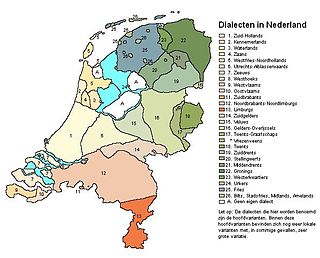 W
WSouth Hollandic is a group of subdialects of the Hollandic dialect that are spoken in the southern part of the Hollandic-speaking area. An example of a South Hollandic dialect is The Hague dialect.
 W
WIn German dialectology, the Speyer line or Main line is an isogloss separating the Central German dialects to the north, which have a stop in words like Appel "apple", from the Upper German dialects to the south, which have an affricate: Apfel. The line begins in Alsace near Strasbourg, and runs north-east to Thüringen, crossing the Rhine at Speyer. After passing close to Erfurt, it turns south-east and continues into the formerly German-speaking parts of Bohemia. The line is exemplified by place-names containing an uncombined /p/ phoneme, which lie north of the line, while those with an affricate /pf/ lie mostly to the south.
 W
WThe Stories of English is a 2004 book by British linguist David Crystal; it traces the history of the English language from the invasion of Great Britain by the Angles and Saxons in the 5th Century to the modern splintering of the language into its modern British, American, Indian, Australian, and other dialects.
 W
WThe Cambridge History of the English Language is a six volume history of English published between 1992 and 2001. The general editor was Richard Hogg.Volume 1, The Beginnings to 1066, Richard Hogg, ed. Volume 2, 1066–1476, Norman Blake, ed. Volume 3, 1476–1776, Roger Lass, ed. Volume 4, 1776–1997, Suzanne Romaine, ed. Volume 5, English in Britain and Overseas: Origins and Development, Robert Burchfield, ed. Volume 6, English in North America, John Algeo, ed.
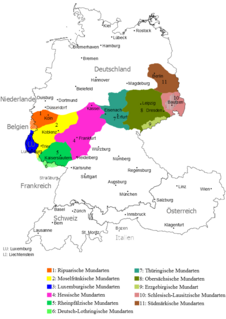 W
WThuringian is an East Central German dialect group spoken in much of the modern German Free State of Thuringia north of the Rennsteig ridge, southwestern Saxony-Anhalt and adjacent territories of Hesse and Bavaria. It is close to Upper Saxon spoken mainly in the state of Saxony, therefore both are also regarded as one Thuringian-Upper Saxon dialect group. Thuringian dialects are among the Central German dialects with the highest number of speakers.
 W
WTrackTest Online English Assessment Center or TrackTest is an online English language assessment tool launched in November 2012 that measures the English skills of non-native English speakers. The test is using the scale based on Common European Framework of Reference for Languages. It wants to create a 21st-century alternative to expensive pen&paper tests provided by established companies like ETS. Services for companies and language schools include easy-to-use online management console for managing tests, analysing results and progress of their employees and students. In 2014, TrackTest English Test was used by students from 173 countries and speaking 136 languages. The organisation is an institutional affiliate member of Association of Language Testers in Europe (ALTE).
 W
WFinds from Vimose, on the island of Funen, Denmark, include some of the oldest datable Elder Futhark runic inscriptions in early Proto-Norse or late Proto-Germanic from the 2nd to 3rd century in the Scandinavian Iron Age and were written in the time of the Roman Empire.Vimose Comb : harja (ᚺᚨᚱᛃᚨ) Vimose Buckle aadagasu =? ansuz-a(n)dag-a(n)su / laasauwija =? la-a[n]sau-wija; Vimose Chape : mariha || [.]ala / makija; possibly "Mari is the sword of Alla" Vimose Woodplane talijo gisai oj: wiliz [..]la o[...] / tkbis: hleuno: an[.]: regu Vimose Sheathplate : awgns; possibly "son/descendant of Awa" Vimose Spearhead: [w]agni[ŋ]o
 W
WThe West Frisian languages are a group of closely related, though not mutually intelligible, Frisian languages of the Netherlands. Due to the marginalization of all but mainland West Frisian, they are often portrayed as dialects of a single language.
 W
WWiedingharde Frisian is a dialect of the North Frisian language spoken in the German amt of Wiedingharde south of the border to Denmark in North Frisia. The dialect forms part of the mainland group of North Frisian dialects. Although it is spoken adjacent to Mooring-speaking Bökingharde, it has more in common with Goesharde Frisian. Like the insular Söl'ring dialect, Wiedingharde Frisian shows influence from Danish and South Jutlandic.